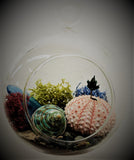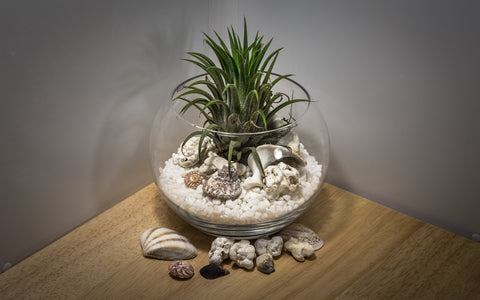TERRARIUMS
Terrariums are indoor container gardens that require little care once established. They are a self- sustaining ecosystem of slow growing tropical or house plants and are best constructed in a glass container with an opening to allow air circulation.
Terrariums require low to medium light as bright direct light will reflect on the glass and burn the plants.
Terrariums look best if planted in a mix of leaf colors and sizes. Choose between drier terrariums for cactus and succulents with a large opening to allow more air or moist terrariums that are closed-necked and capped for leafy plants.
The Best Plants for Terrariums are:

- Pothos
- Hypoestes (Polka Dot)
- Ferns small (Button Ferns)
- Club Moss
- Maranta (Prayer Plants)
- Pilea, Peperomia
- Creeping Fig
There are others that remain small and will not outgrow the terrarium. Check with The Mill's garden center for a selection of terrarium suitable plants.
How to Make a Terrarium
- Select a glass container without drainage with an opening that can be sealed.
- Add 2” pea gravel
- ¼” to ½ ” of activated charcoal
- A piece of sheet moss to keep soil from mixing with gravel and charcoal
- 3”- 4” sterile potting mix on top of the moss.
- There should be 4-6” of space from the soil line to the narrowing of the neck of the container.
- Have a design in mind prior to planting. Mound areas and add hardscaping, as this will increase interest in your ecosystem.
- If the opening is narrow, you can use long-handled spoons or long tweezers to dig and place plants. A cork on the end of a chopstick will work as a tamp to set plants firmly in place.
- Water with a spray bottle so the plants are just damp not soaking wet and wash any debris off the side of the glass container.
- Place in filtered light and check biweekly looking for condensation on the sides. If there is condensation, open the lid and allow for air to dry off the glass. Replace the lid once the sides are dry. If there is no condensation, check soil for dryness and water if needed just until soil is damp. Prune out any dead leaves to keep all healthy and never apply fertilizer as the plants will have enough in the potting mix and their roots will disperse nutrients.











